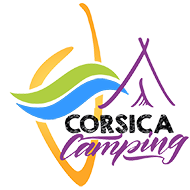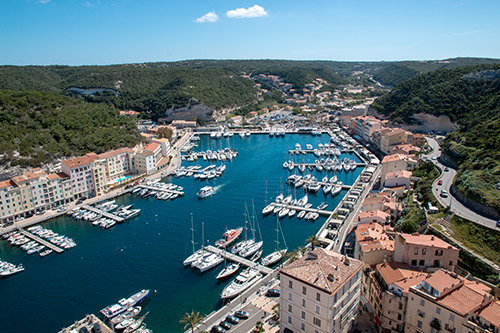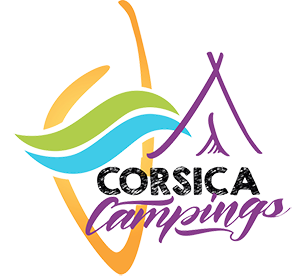Alta Rocca means “high rock” and well represents the panorama of the surrounding area. The region is accessible from Solenzara, Porto-Vecchio or Ajaccio. For the more sporty among you, set off for a 6-day getaway on the Mare à Mare sud hiking trail, from Propriano towards Porto-Vecchio.
Main village of the region with its 700 inhabitants, you will find local shops and stores in Levie to discover the Corsican region. The village is recognized thanks to its prehistoric buildings such as the still very well preserved fortifications, located in the Levie plateau (Pianu di Luvia). It is accessible through a walk in the forest of the Castello di Cucueuzzu. It is also advisable to visit the archaeological museum of the Alta Rocca Museum. It opened in 2007. At the heart of the museum’s collection, the oldest human remains found on the island are on display: the skeleton of the Lady of Bonifacio.
The Cucuruzzu site is one of the most important witnesses of the Bronze Age (i.e. 2nd millennium BC). You will access it by a staircase cut into the rock. The surrounding walls are 5 meters high and surround a space of 400m². The torra is a tower 8 meters in diameter and 5 meters high. It was used as a pantry and also as a defensive place for the villagers in the event of an attack. Below, you can discover the remains of the village. The shelters were discovered between 1977 and 1984. A marked path goes down to the various points of interest on the site and offers visitors an impressive view of the region as well as the Bavella needles. Objects from daily life of the time have been found and are kept at the Alta Rocca museum in Levie.
From Levie, follow the D268 to go towards Zonza via San Gavino-di-Carbini. Between Zonza and the needles of Bavella, is the Viseo racecourse. Several times a year races take place and it is the highest in altitude in all of Europe. The tour in Alta Rocca continues towards the villages of Cargiaca and Loreto-di-Tallano. The village of Sainte-Lucie-de-Tallano is recognized thanks to its geology, with the presence of rare diorite balls, also called Orbiculit. In the world we find these circular inclusions only in Sweden, Finland or Austria. Above the village is the Franciscan monastery of Saint-François, founded in 1492. From the village, on the D268, you arrive at Levie.
To discover the needles of Bavella (40km from Solenzara), take the D268. The pass, at an altitude of 1,218m, is the starting point for many hikes. The road serves as a connection between the eastern and western part of the island. The Bavella massif is characterized by its jagged peaks, wind-twisted pines and imposing rock walls. The villages in the area are: Quenza, Zonza and Conca. The Notre-Dame-des-Neiges statue stands on the road towards the pass. The ”bomb hole” and the Purcaraccia stream are renowned for their waterfalls and natural swimming pools. From Sartène, the N196 towards Bonifacio arrives in the south of the island. The road leads to Bocca di Roccapina. Coming back down from the pass, the road offers a view of the many bays and beaches in the region. The route continues towards Figari and its flying club. Flights are offered to fly over Bonifacio, the Lavezzi Islands or the beaches around Porto Vecchio. The village of Figari is home to many wine growers and tastings are also offered at the wine estates.
The city of Bonifacio was founded in 828 by Count Bonifacio of Tuscany, who built the Citadel to defend his territory. The city was taken over by the Genoese during the 12th century and they implemented works to construct new buildings and assert their power. You have to head towards the port and upper town to discover the heights of Bonifacio as well as the marine cemetery. Located on a plateau called the Bosco, the cemetery is made up of white tombs, and is considered one of the most beautiful in the Mediterranean. There is also the Saint-François church dating from the 13th century. There is another church in the old town, the Sainte-Marie-Majeure built during the same period. Inside the building there is a Roman sarcophagus from the 3rd century and baroque style ornaments. When you follow the directions ”Staircase of the King of Aragon”, you arrive in front of an imposing staircase, built in the rock, where many legends are told about its origin. The path continues a few meters above the sea, to arrive at a small cave. The city was fortified with 2.5km of ramparts. It is now possible to follow the marked trail which begins at Col Saint-Roch to, for 1h30, walk along the cliffs and admire the panorama. The path reaches the Capo Pertusato lighthouse. The Pertusato lighthouse has an important role in maritime navigation in the region. The short distance between the two islands makes the crossing dangerous. At the tip of Sperone there is one of the most beautiful golf courses in the world.
As you walk along the quays of the port of Bonifacio, many boats leave towards the Lavezzi Islands and also take a tour near the chalk cliffs and its caves. The archipelago of 8 granite islands is located 3 km off the coast of Bonifacio. No shops, cars, or accommodation to spend the night, just sandy beaches and granite islets, ready to welcome you to relax in crystal clear waters. A real postcard shot! When we leave Bonifacio towards Porto Vecchio, the N198 takes us to Balistra beach and a little further behind its pond. 5 km further is Rondinara beach, which is one of the most beautiful beaches in Corsica, then Santa Giulia.
The town of Porto Vecchio is divided into two parts: the marina and its shops and the old town, perched 70m high. At the port, excursions are offered to go to Bonifacio, the Lavezzi islands or the island of Cavallo. From the quays, Rue Dragut and Fontana Vecchia lead visitors towards the old town. It is accessed through the Porte Génoise. The city center is Place de la République, in front of the Saint-Jean-Baptiste church, dating from 1868. Terraces offer beautiful views of the city’s gulf. On the southern as well as northern part of the Gulf of Porto Vecchio, there are numerous beaches: Tamarucciu, Acciaju, or the bay of San Ciprianu. There is also Palombaggia beach, one of the most beautiful on the island, with its red rocks and white sand.
Around the seaside resort, the region is home to the site of Castellu d’Arraggio (or Araghju). Accessible from the D368, take the direction of Ospédale and Zonza, then towards the hamlet of Palavese. The plateau offers a panoramic view of the plain and the sea. The entire monument is 120m long. It is composed of a large entrance with the guard’s room, as well as a cult monument. In the northern part of the site, we find the rooms of the tribal chiefs. The excavations began in 1967, by Roger GROSJEAN. There is a second site, located south of Porto Vecchio, towards Bonifacio, in the hamlet of Ceccia. Pieces found during excavations begun in the early 1960s are exhibited at the Museum of the Prehistory of Corsica in Sartène.


